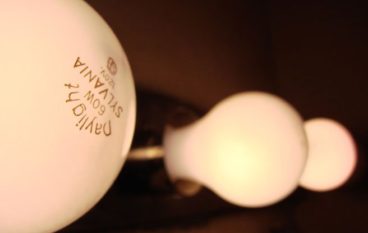Incandescent light bulbs become a thing of the past, starting tomorrow

This has been a long time coming, but the day is finally here. On New Year’s Day, it officially becomes illegal for manufacturers to supply the Canadian market with general-purpose 75 and 100-watt incandescent light bulbs. From now on, because of energy-efficiency regulations that began to be adopted by the federal government in 2007, the only household bulbs available in those wattages will be the more-efficient compact-flourescent and LED models. Certain types of utility incandescent bulbs are exempt from the ban.
Downcast consumers can take solace in the fact that the new bulbs, while more expensive, can last between six and 40 times as long as the old ones—plus, retailers will be allowed to sell off their remaining stock of incandescents, so hoarding is an option. Halogen bulbs are also included in the ban, though the feds plan to exempt them in the near future. 60- and 40-watt incandescent bulbs are still legal for the time being, but a ban on them goes into effect at the end of 2014.






On my way to the hardware store! Thanks for the heads-up.
Why? When the price of electricity is going. Incandescent bulbs use a lot more electricity.
If its the colour of the light you’re worried about, just get a 2,700K CFL or LED bulb. That’s the colour temperature you would look for if that’s what worrying you. Daylight has a 5,500K colour temperature.
LED and fluorescent are so tacky and unromantic. . It’s not just the hue that bothers me.
What about photographers who need to buy bulbs for specific lighting? I doubt it will be illegal for them to sell photographic studio equipment.
Strange to ban a popular safe product and push arguably unsafe ones –
the opposite to usual practice.
Even more strange to do it in Canada
Incandescents have many specific advantages for Canadians, living in
relatively large homes where much time is spent with varied lighting
conditions, and where incandescent light quality, reaction time,
brightness, sensor/dimming and other versatility is welcome.
New bulbs are desirable = no point banning old ones
New bulbs are not desirable = no point banning old ones.
It is simply a ban to reduce electricity consumption.
Even if bulbs (dubiously) needed targeting for that purpose, that
would rather mean taxation and government income while keeping choice
On referenced grid data, mainly small off-peak evening surplus
electricity use, and base loading coal plants on minimum night cycle
burn the same coal anyway regardless of bulb used, again referenced.
The light bulb ban makes no sense
– except for major manufacturers (as also mentioned in the Govmt ban
proposal) who lobbied for and got ban on cheap patent expired generic
lighting, relatively unprofitable compared to complex patented
expensive alternatives.
Re the last comment,
a full summary of why ban is wrong
http://freedomlightbulb.org/2013/12/canada-light-bulb-ban-summary-of-how-it.html
Re last comment
see full summary of why light bulb ban wrong
on freedomlightbulb org
The Nat Resources Dept and Minister Oliver justify the ban by saying
“10% of domestic electricity is used for lighting”
This ignores that around half of domestic lighting is not incandescent anyway, especially the mainly used kitchen lighting, also that replacements use electricity, also the heat replacement of incandescents and power factor (PF) issues of CFLs and LEDs (effectively energy use not recorded by the meters), also that domestic electricity is a small part of overall grid demand (industrial, commercial, municipal, transport – with hardly any incandescent use in any of those sectors).
On a general level, also the life cycle energy use of more complex replacement lighting, including transport in all stages from mineral mining to recycling (when not dumped, leeching mercury etc) and bunker oil powered shipping from China by major manufacturers, compared to easier local Canada manufacture by small/new manufacturers of patent-free simple incandescent bulbs.
Incandescent electricity use is just fractional amounts of mostly off-peak evening-night surplus electricity, as per usage and grid data references, effectively smaller still given the bulb heat supplied as per Ontario/BC institutional studies, and with the Canadian Center for Housing Technology also confirming that 83% to 100% of lighting energy contributes to heat demand reduction.
“The total reduction [in energy use] would be 0.54 x 0.8 x 0.76% = 0.33%,
This figure is almost certainly an overestimate,
particularly as the inefficiency of conventional bulbs generates heat which supplements other forms of heating in winter.
Which begs the question: is it really worth it?
Politicians are forcing a change to a particular technology which is fine for some applications but not universally liked, and which has disadvantages.
The problem is that legislators are unable to tackle the big issues of energy use effectively, so go for the soft target of a high profile domestic use of energy…
…This is gesture politics.”
Using comparable European Commission VITO data to similarly cut down even greater “15% of domestic electricity use” type statements, this came from the Cambridge University Scientific Alliance, UK Government advisers from several institutions normally supportive of energy and emission measures, similarly with other referenced science institution communications from different countries (see previous website link).